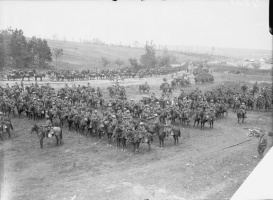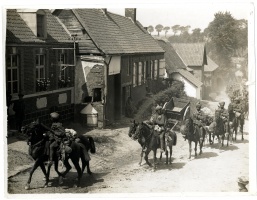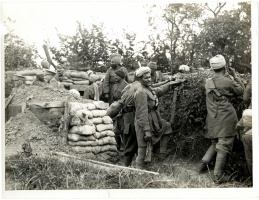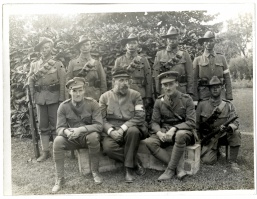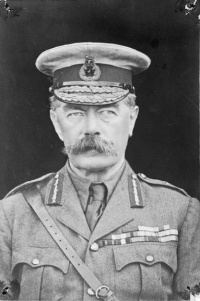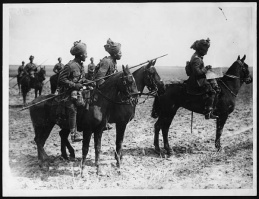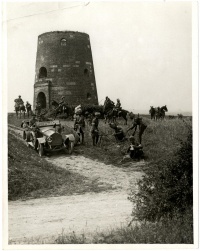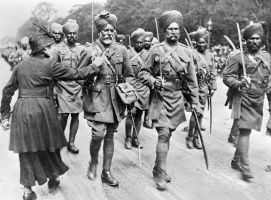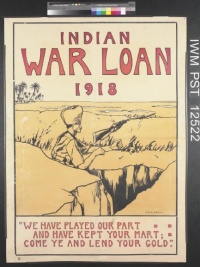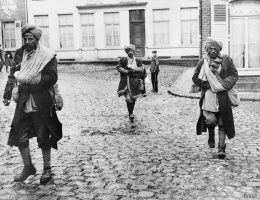Introduction↑
Existing research is strong on these issues, as the bibliography and notes to this article indicate. In particular, Tan Tai-Yong and Tahir Mahmood have perceptively analysed military recruitment in wartime Punjab, while Radhika Singha has undertaken pathbreaking research on the recruitment of Indian non-combatant labour. The article will first consider the structure and function of the pre-war Indian army, and its initial mobilization on the outbreak of war. It then will analyse the extensive changes to recruitment brought about by the demands of the war, focussing in particular on Punjab, which supplied the majority of the Indian army’s troops. The article also considers the recruitment, treatment and experiences of Indian non-combatants (or “followers”) who provided essential support to the armed forces. The article concludes by assessing the extent to which mobilization for war changed the political dynamics of the colonial relationship between Britain and India.[1] In examining these questions it is important to be aware that many of the sources, such as the memoirs of the wartime governor of Punjab, Sir Michael O’Dwyer (1864-1940), are “top-heavy”, although the article does attempt to present perspectives “from below”, for example through the use of Indian soldiers’ letters.[2]
Before the War↑
Recruitment to the Indian army from the late 19th century had been driven by the theory of the “martial races”, which was particularly associated with Lord Frederick Roberts (1832-1914), commander-in-chief in India from 1885 to 1893. He thought that soldiers recruited from south India were “unwarlike”, and should be replaced with “hardier” men from the north. Many regiments recruited in South India were disbanded from the 1880s to the 1900s.[3] They were replaced by regiments recruited from the “martial races”, the most famous of which were the Sikhs from Punjab and the Gurkhas from Nepal;[4] both particularly favoured by Roberts. The single most numerous “class” of Indian recruits in both world wars, however, was the Punjabi Muslims. At the outbreak of war in 1914, approximately one half of the Indian army was recruited in Punjab, one sixth from the Pathans and Gurkhas, and less than one third from the rest of India.[5]
Lord Horatio Herbert Kitchener (1850-1916) had been appointed commander-in-chief in India in 1902 after the South African War. He found the Indian army in a poor state of organization, with its units scattered, as he put it, “all higgledy-piggledy over the country, without any system or reason whatever”.[6] The troops were distributed all over India, normally by single regiments, mainly for internal security purposes. Regiments were not even collected for training, and there were no clear plans for the creation and command of brigades in wartime. Kitchener reduced the internal security troops to the minimum he thought necessary, freeing enough battalions to increase the field army divisional areas from four to nine.[7] Divisional commanders were given a clear sense of what their role would be in the event of war. He also extended the policy of the “martial races”, disbanding regiments recruited in the south, and replacing them with troops drawn from the north.
During the early battles on the Western Front, despite the poor conditions and initial lack of modern equipment, most of the well-trained and experienced Indian troops showed courage, initiative, and excellent marksmanship.[8] In the matter of recruitment, however, the Indian military system was “ill-prepared for war”.[9] In the first place, the Indian army was far smaller than the vast conscript armies of continental Europe.
| British Officers | 2,333 |
| Reserve of Officers | 40 |
| Indians of All Ranks: Serving | 159,134 |
| Indian Reservists | 34,767 |
| Indian Non-combatants | 45,660 |
| Total | 241,934 |
Table 1: Strength of the Indian Army, 1914[10]
The main functions of the Indian army were internal security and frontier warfare. It was not normally considered to be the duty of the government of India to maintain forces out of Indian revenues to serve overseas. By 1913, however, six infantry divisions and six cavalry brigades had been fully equipped for war.[11]
The Outbreak of War↑
When George V, King of Great Britain (1865-1936) declared war on Germany in August 1914, he did so on behalf of the whole empire.[12] India was therefore also at war. At the outbreak of war there were enthusiastic expressions of loyalty.[13] Many Indian newspapers argued that the cause was just.[14] Indian nationalists hoped that the war would prove India’s loyalty, and, by extension, its ability to self-govern. There was initially “a steady flow of recruits to the Indian Army”.[15] This picture was, however, to change as the war dragged on and its impact deepened in India.
The Indian army had previously been used as an imperial “fire brigade” throughout the Indian Ocean region, and as far east as China. It had not, however, been employed on a significant scale in “white man’s wars” such as in the Crimea and South Africa.[16] The decision to employ Indian troops in Europe against the Germans was therefore a significant one. In 1911, the Committee of Imperial Defence “had proposed the despatch of two Indian infantry divisions and one cavalry brigade to Europe”.[17] In 1914, King George wanted Indians to serve in Europe, and the viceroy, Charles Hardinge, Baron Hardinge of Penshurst (1858-1944) supported him.[18] There was widespread enthusiasm in India at the news that the Indian army was to serve in Europe on what seemed to be similar terms to the British army.[19] The Indian Expeditionary Forces were also sent to Egypt, East Africa and Persia. The principal theatre of war for the India army would, however, be Mesopotamia.
The outbreak of war immediately raised the problem of how to adjust from peacetime to wartime recruitment. Pre-war recruitment had been mostly carried out by regimental parties, but this was not a system suitable for the demands of a major war. Regimental recruiting parties sometimes competed for the same men.[20] The martial race system made it difficult to find recruits of the right “class” for segregated units. There were also serious problems with the reservists arriving in France. Many of these men had passed into the reserves after long service, and were too old or in poor shape.[21] As casualties mounted, the battalions in India were effectively transformed into training battalions for battalions overseas.[22] The 1913 Nicholson Committee had considered that extra inducements would be necessary to sustain recruitment in wartime.[23] As the war continued, it became clear that the whole recruiting system would have to be overhauled.
As early as November 1914, Lieutenant-Colonel Rule, a recruiting officer in the Amritsar District, noted cases of Indian women who followed recruiting parties for miles, hoping for the chance to lure away their recently enlisted menfolk.[24] By 1915, heavy casualties had started to deter enlistment.[25] Soldiers also wrote home to discourage others from enlisting. In May 1915, for example, a Muslim havildar wrote to another Muslim soldier then serving in Baluchistan:
Turkey’s entry into the war had a potential impact in India.[27] Mehmet V, Sultan of the Turks (1844-1918) in his capacity as Shaik al-Islam proclaimed Jihād against the Allied powers on 14 November 1914.[28] Around 35 percent of the Indian army’s troops were Muslims, who would now be further exposed to German-sponsored pan-Islamic propaganda. There was concern that the recruitment of Muslim troops in India, and the loyalty of those already serving, might be compromised.[29] Indeed, in February 1915 there was a mutiny in Singapore, in which Muslim troops turned on their officers, killing them and other Europeans in the neighbourhood. Most of the mutineers were captured, and forty-seven of them sentenced to death.[30] In early March, an Indian officer and about twenty men in France deserted to the Germans. Some of the deserters, together with German agents, reached Kabul towards the end of the year. For much of 1915 there was serious concern in viceregal circles that Afghanistan might enter the war. In early 1916, a Muslim cavalry regiment, the 15th Lancers, peacefully refused to advance from Basra because they did not wish to fight against the Turks near the Muslim holy sites of Mesopotamia.[31]
The peacetime level of recruitment in India had averaged around 1,250 men per month. Losses mounted, and only by the end of 1915 did the number of new recruits rise to the 10,000 a month needed to replace wartime wastage.[32] In April 1916 the British government made it clear that they wanted greater involvement of the Indian civil administration in recruiting.[33] The commander-in-chief in India, General Sir Charles Monro (1860-1929), pressed the same view on the viceroy. Over 200,000 men entered the Indian army between 1914 and 1916.[34]
| Year | Punjab (mostly Muslims and Sikhs) | Nepal (Gurkhas) | Frontier and Trans-Frontier (Pathans) | Rest of India | Total |
| 1914 | 14,000 | 3,000 | 3,000 | 8,000 | 28,000 |
| 1915 | 46,000 | 14,000 | 6,000 | 28,000 | 93,000 |
| 1916 | 50,000 | 15,000 | 5,000 | 32,000 | 104,000 |
| Total 1914-1916 | 110,000 | 33,000 | 14,000 | 68,000
|
225,000 |
Table 2: Combatant Enlistments in the Indian Army, 1914-1916[35]
The Later War Years↑
In September 1916, in a memorandum submitted to Frederic Chelmsford, Lord Chelmsford (1868-1933), who had been appointed viceroy in April, the governor of the Punjab, Sir Michael O’Dwyer stressed that the civil government of Punjab needed to be “intimately acquainted with the temper and conduct” of the troops of the Indian army.[36] Moreover, he underscored the importance of Punjab’s government being more closely involved in recruiting, and that the civil and military authorities should work together to effectively mobilize the manpower of the province.[37] The military machine was reorganized.[38] Rural notables and pirs were engaged in the recruiting drive.[39] There was some competition among them to win favour with the British authorities, and hence honour and land, by providing the most recruits, although subsequently there was some resentment at the uneven ways that these rewards had been distributed.[40] A Provincial Recruiting Board, chaired by O’Dwyer, was set up in June 1917 to administer the recruiting campaign.[41] The primary responsibility for recruitment was also transferred from regimental depots to provincial governments.[42]
In mid-November 1916, the Indian government was “asked what further help they could give”.[43] In May 1917, the government appointed a Central Recruiting Board.[44] Sir William Meyer (1860-1922) was appointed its president. The other members were the adjutant-general (who was made responsible for all recruiting), the secretary of the army department, two Indian princes, and Sir Michael O’Dwyer. The board increased recruiting across India.[45]
Early in 1917, further incentives were introduced, including free rations; later on recruits received an enlistment bonus of Rs50.[46] The government of India also decided to widen the basis of recruitment.[47] In late 1917, many different classes were being recruited in Punjab, where the government drew upon areas, particularly in the southwest of the province, which did not have military traditions.[48] Elsewhere in India, recruitment was extended to those communities previously considered “un-martial”, including Mahars, Bengalis, and Punjabi Christians.[49] That said, Bengal, with a male population of 23 million, still had only one active battalion, mostly composed of middle-class citizen-soldiers (mainly bhadraloks), and which did not see action at the front.[50]
Throughout the war, Punjab was the main source of recruits to the Indian army; out of 683,149 combat troops recruited in India between 1914 and 1918, 349,688 came from that province.[51] By the end of the war one in twenty-eight of the male population of the Punjab had been mobilized.[52] In Punjab, the whole administrative structure of the province was geared for the war.[53] No other provincial government followed Punjab’s example to the same extent, however.
The Indian army’s military effort was supported by a large number of non-combatant “followers”. These included medical and veterinary personnel; grass-cutters, blacksmiths and grooms; sweepers, cooks, valets, cobblers, and postal workers; and the many skilled and unskilled labourers who built and maintained roads, railways, and the inland water transport system in Mesopotamia. The number who served was 563,368, of whom 348,735 had been sent to Mesopotamia by 31 December 1919. Important scholarship has begun to recover their often-neglected history.[54] Indian labour recruiting could not be made compulsory, for it could have disrupted existing patterns of labour migration, although non-combatant recruitment did become centralized by late 1916. The Indian government distanced non-combatant labour recruitment from the stigma of indentured (or “coolie”) labour by using the Indian Army Act to reframe labour as “war work overseas”. Despite this gesture, the labourers often worked in poor conditions, particularly in Mesopotamia. In France, the Indian Labour Corps salvaged material from battlefields, which was particularly important work in the context of the German submarine blockade of 1917-1918. They also built roads and railways, and cut timber. Their presence enabled the more rapid demobilization of many British soldiers after the armistice. Indian labourers were never officially recognized as combatants, unlike those serving in British labour battalions. Indian labourers were drawn to the work by the attractions of a wage, good food and clothing, and a chance to see the world. They were recruited from a wide range of communities, typically different from those who supplied military recruits. Some labourers in Iraq were even recruited from Indian jails, such was the demand for war work overseas.
In February 1917, British Prime Minister David Lloyd George (1863-1940) asked for additional efforts from India.[55] In March 1917, the Indian government agreed to raise twenty-four new battalions.[56] The recruiting quota for Punjab was set at 204,000 for the year beginning 1 July 1917.[57] From 1917 to the end of the war the Indian army doubled in size, but many of the new troops lacked training and experience.[58]
| Year | Punjab | Nepal | Rest of India | Total |
| 1917 | 95,000 | 12,000 | 91,000 | 198,000 |
| 1918 | 134,000 | 10,000 | 183,000 | 327,000 |
Table 3: Combatant Recruits to the Indian Army, 1917-1918[59]
This increase in military recruitment was taking place in the context of, and was supporting, the movement for Home Rule in India.[60] The main Indian political parties, the Indian National Congress and the Muslim League, had agreed on a platform through the Lucknow Pact of December 1916.[61] Congress demanded a proclamation that it was “the aim and intention of British policy to confer self-government on India at an early date”.[62] The viceroy and the secretary of state for India, Edwin Montagu (1874-1924), were both convinced that some political gesture was needed.[63] The result was the famous statement of 20 August 1917, which announced that the goal of British policy was the “increasing association of Indians in every branch of the administration and the gradual development of self-governing institutions with a view to the progressive realisation of responsible government in India as an integral part of the British Empire”.[64] The term “responsible government” was assumed by some to imply an eventual transfer of power. The Montagu declaration was well received, but it fell far short of what United States President Woodrow Wilson (1856-1924) seemed to promise about self-determination in his Fourteen Points.
In October 1917, the Bolsheviks overthrew the Russian provisional government, and in March 1918, following the treaty of Brest-Litovsk, Russia left the war. These developments had huge implications for the Allies. During the winter of 1917-1918, the Germans were able to switch divisions from the Eastern Front to the west, in preparation for a major offensive in the spring. In February 1918 Lloyd George asked for an even greater effort from India.[65] On 2 April, he published a message claiming that India would “be the bulwark which will save Asia from the tide of oppression and disorder which it is the object of the enemy to achieve”.[66] India’s military recruiting quota for 1918-1919 was set at 500,000, “which would have maintained existing units at strength and have enabled 91 new battalions to be formed”.[67] As before, Punjab was to take the lion’s share, with a target of 180,000 combatants and 20,000 non-combatants.[68] If voluntary measures failed, the government of Punjab would have had to resort to conscription.[69] This proved unnecessary, but, had the war continued, other provinces might also have been mobilized in the same way.
In his memoirs, Michael O’Dwyer claimed that “while no legitimate form of appeal [was] neglected, there was … nothing savouring of coercion or compulsion”.[70] Unpublished government documents show, however, that “press-gang” methods of recruiting had been resorted to in Punjab by February 1918.[71] Recruits were even being bought and sold. In some areas there was resistance to recruiting, with riots and disturbances in three or four of the twenty-eight districts of the Punjab. In his book Gandhi and Anarchy (1922), Sir Sankaran Nair (1857-1934) accused O’Dwyer of using “terrorist” methods to obtain recruits.[72] O’Dwyer fought a successful libel action over the phrase, and was awarded £500 damages.[73] An enquiry by the Indian National Congress, however, found numerous examples of coercive recruiting.[74]
The Aftermath↑
By the end of December 1919 almost 1.5 million Indians had been recruited in combatant and non-combatant military roles.[75] What impact did this impressive military effort have upon the colonial relationship between Britain and India? The anti-colonial rhetoric of Woodrow Wilson had raised expectations in India as elsewhere in the colonial world. At the armistice, hopes for the impending peace settlement were high. India’s mobilization had made a significant contribution to the Allied war effort, and “political” India demanded some form of reward in the form of a greater say in how India was governed. In this context, the Montagu-Chelmsford Report, published in July 1918, did not go far enough.[76] In December, congress and the Muslim League had both demanded self-determination, only to be disappointed in the spring of 1919.[77] Returning soldiers carried with them some of the mood.[78] Demobilized ex-soldiers were involved in the Punjab disturbances of 1919.
In December 1919, Viceroy Chelmsford protested that India still had to bear the cost of maintaining a large army on imperial business in the Middle East. India, he claimed, was “being exploited by the War Office” because India could “maintain Indian troops abroad without those extremely objectionable questions in parliament which would be asked if they were British”.[79] Substantial Indian forces remained overseas in the region well into the 1920s.[80]
Conclusion↑
Until the outbreak of war, the main role of the Indian army had been to defend India’s frontiers and to maintain internal security. There was no effective reserve system. From 1914 to 1918, the Indian army acted as a major imperial strategic resource, for which the peacetime Indian military system was unsuited. The Indian army fought a major campaign in Mesopotamia, and was active on many other fronts. Providing the necessary manpower required significant involvement by the civilian government in both military and non-combatant recruiting. Wartime military mobilization, and post-war discontent, was greatest in Punjab, although the rest of India’s vast manpower was not fully tapped, at least in combatant roles. Unlike the British army, the Indian army was still expanding at the end of the war, and reached its largest size in this period during the war with Afghanistan in 1919. Once the internal situation in India became more stable, military reforms were enacted which incorporated some of the lessons of recruiting in 1914-1918. Most notably, in 1922, the Indian infantry were grouped into regiments of up to six battalions, one of which served as the regiment’s training battalion, intended, in any future war, to send trained soldiers to the battalions at the front. This system was still in force on the outbreak of war with Germany in 1939.
David Omissi, University of Hull
Section Editor: Santanu Das
Notes
- ↑ Brown, Judith: Modern India. The Origins of an Asian Democracy, Oxford 1994, p. 194.
- ↑ Some historians have also examined the substantial, if largely vernacular and visual sources – such as recruitment journals and posters, songs, verses and pamphlets – which shed further light on the recruitment process: see Das, Santanu: India, Empire, and First World War Culture, Cambridge 2018, pp. 75-116.
- ↑ Streets, Heather: Martial Races. The Military, Race and Masculinity in British Imperial Culture, 1857-1914, Manchester 2004, pp. 99-101.
- ↑ Perry, Frederick William: The Commonwealth Armies. Manpower and Organization in Two World Wars, Manchester 1998, p. 85.
- ↑ O’Dwyer, Michael: India as I Knew It, London 1925, p. 214.
- ↑ Magnus, Philip: Kitchener. Portrait of an Imperialist, London 1958, p. 198.
- ↑ Perry, Commonwealth Armies 1998, p. 83.
- ↑ Morton Jack, George: The Indian Army on the Western Front, 1914-1915. A Portrait of Collaboration, in: War in History 13/3 (2006), pp. 334-348.
- ↑ Rumbold, Algernon: Watershed in India, 1914-1922, London 1979, p. 24.
- ↑ Perry, Commonwealth Armies 1998, p. 86.
- ↑ Ibid., pp. 83-85.
- ↑ Stockwell, A. J.: The War and the British Empire, in: Turner, John (ed.): Britain and the First World War, London 1988, p. 37.
- ↑ Rumbold, Watershed 1979, p. 20.
- ↑ Jarboe, Andrew Tait (ed.): War News in India, London 2016, pp. 15-50.
- ↑ James, Lawrence: Raj. The Making and Unmaking of British India, London 1997, p. 441.
- ↑ Omissi, David: India. Some Perceptions of Race and Empire, in: Omissi, David / Thompson, Andrew S. (eds.): The Impact of the South African War, Basingstoke 2002.
- ↑ James, Raj 1997, p. 440; Perry, Commonwealth Armies 1998, p. 84.
- ↑ Omissi, David: Europe Through Indian Eyes. Indian Soldiers Encounter England and France, 1914-1918, in: English Historical Review 122/496 (2007), p. 373-374.
- ↑ O’Dwyer, India as I Knew It 1925, pp. 215-216.
- ↑ Tan Tai-Yong: An Imperial Home Front. Punjab and the First World War, in: Journal of Military History 64/2 (2000), p. 380.
- ↑ Perry, Commonwealth Armies 1998, p. 88; Morton Jack, The Indian Army on the Western Front 2006, p. 346.
- ↑ Perry, Commonwealth Armies 1998, p. 89.
- ↑ O’Dwyer, India as I Knew It 1925, p. 214.
- ↑ Tan, Imperial Home Front 2000, p. 383; see footnote 45.
- ↑ James, Raj 1997, p. 451.
- ↑ Havildar Abdul Rahman (Punjabi Muslim), 59th Rifles, France, to Naik Rajwali Khan, 31st Punjabis, Fort Sandeman, Zhob District, Baluchistan, 20th May 1915 [Urdu], in: Omissi, David (ed.): Indian Voices of the Great War. Soldiers’ Letters, 1914-1918, Basingstoke 1999.
- ↑ Omissi, David: The Greatest Muslim Power in the World. Islam, the Indian Army and the Grand Strategy of British India, 1914-1916, in: Jeffreys, Alan (ed.): The Indian Army in the First World War. New Perspectives, Solihull 2018, p. 158.
- ↑ Lewis, Geoffrey: The Ottoman Proclamation of Jihād in 1914, in: Arabic and Islamic Garland. Historical, Educational and Literary Papers presented to Abdul-Latif Tibawi, London 1977, p. 159.
- ↑ Perry, Commonwealth Armies 1998, p. 90.
- ↑ Stockwell, The War and the Empire 1988, p. 46.
- ↑ James, Raj 1997, p. 452.
- ↑ Rumbold, Watershed 1979, p. 28.
- ↑ O’Dwyer, India as I Knew It 1925, p. 218; Tan, Imperial Home Front 2000, p. 385.
- ↑ Perry, Commonwealth Armies 1998, p. 90.
- ↑ O’Dwyer, India as I Knew It 1925, pp. 216-217. The figures have been rounded to the nearest thousand, so do not exactly add up. See also Omissi, The Sepoy and the Raj 1994, p. 39.
- ↑ Tan, Imperial Home Front 2000, p. 386.
- ↑ Ibid., p. 389.
- ↑ O’Dwyer, India as I Knew It 1925, p. 218.
- ↑ Tan, Imperial Home Front 2000, pp. 400-402.
- ↑ Mahmood, Tahir: Collaboration and British Military Recruitment. Fresh Perspectives from Colonial Punjab, in: Modern Asian Studies 50/5 (2016), pp. 1490-1495.
- ↑ Ibid., p. 1490.
- ↑ Rumbold, Watershed 1979, pp. 27-28.
- ↑ Ibid., p. 28.
- ↑ O’Dwyer, India as I Knew It 1925, p. 220.
- ↑ Ibid., pp. 221-222.
- ↑ Ibid., p. 223.
- ↑ Ibid., p. 227.
- ↑ Ibid., p. 221.
- ↑ Perry, Commonwealth Armies 1998, p. 93.
- ↑ O’Dwyer, India as I Knew It 1925, p. 223.
- ↑ Tan, Imperial Home Front 2000, p. 374; Omissi (ed.), Indian Voices 1999, Appendix III.
- ↑ Woods, Philip: O’Dwyer, Sir Michael (1864-1940), Oxford Dictionary of National Biography, Oxford 2004.
- ↑ Tan, Imperial Home Front 2000, p. 374; Jarboe, War News in India 2016, p. 6; Mahmood, Collaboration and British Military Recruitment 2016, p. 1489.
- ↑ Singha, Radhika: The Short Career of the Indian Labour Corps in France, 1917-1919, in: International Labor and Working-Class History 87 (2015), pp. 27-62; and Singha, Radhika: Finding Labor from India for the War in Iraq. The Jail Porter and Labor Corps, 1916-1920, in: Comparative Studies in Society and History 49/2 (2007), pp. 412-445.
- ↑ Perry, Commonwealth Armies 1998, p. 93.
- ↑ Rumbold, Watershed 1979, p. 28.
- ↑ O’Dwyer, India as I Knew It, 1925, p. 221.
- ↑ Perry, Commonwealth Armies 1998, p. 95.
- ↑ O’Dwyer, India as I Knew It 1925, p. 225. Figures rounded to the nearest thousand.
- ↑ Manela, Erez: The Wilsonian Moment. Self-Determination and the International Origins of Anticolonial Nationalism, Oxford 2007, pp. 82–83.
- ↑ Rumbold, Watershed 1979, p. 51.
- ↑ Brown, Modern India 1994, pp. 198-200; Rumbold, Watershed 1979, p. 89.
- ↑ Stockwell, The War and the Empire 1988, p. 47.
- ↑ Brown, Modern India, p. 204.
- ↑ Rumbold, Watershed 1979, p. 28.
- ↑ Ibid., p. 29.
- ↑ O’Dwyer, India as I Knew It 1925, p. 219; Rumbold, Watershed 1979, p. 30.
- ↑ Tan, Imperial Home Front 2000, p. 406.
- ↑ O’Dwyer, India as I Knew It 1925, p. 221.
- ↑ Ibid., p. 219.
- ↑ Tan, Imperial Home Front 2000, pp. 404-405; Mahmood, Collaboration and British Military Recruitment 2016, p. 1490.
- ↑ O’Dwyer, India as I Knew It 1925, p. 221.
- ↑ Woods, O’Dwyer 2004.
- ↑ Sarkar, Sumit: Modern India, 1885-1947, London 1989, p. 169.
- ↑ Brown, Modern India 1994, p. 195.
- ↑ Manela, Wilsonian Moment 2007, p. 91.
- ↑ Ibid., p. 96.
- ↑ Sarkar, Modern India 1989, p. 176.
- ↑ Stockwell, The War and the Empire 1988, p. 44.
- ↑ Perry, Commonwealth Armies 1998, p. 97.
Selected Bibliography
- Brown, Judith M: Modern India. The origins of an Asian democracy, Oxford 2013: Oxford University Press.
- Das, Santanu: India, empire, and First World War culture. Writings, images, and songs, Cambridge 2018: Cambridge University Press.
- Greenhut, Jeffrey: The imperial reserve. The Indian Corps on the Western Front, 1914-15, in: The Journal of Imperial and Commonwealth History 12/1, 1983, pp. 54-73.
- James, Lawrence: Raj. The making and unmaking of the British India, London 1997: Little, Brown.
- Jarboe, Andrew Tait (ed.): War news in India. The Punjabi press during World War I, London 2016: Bloomsbury Academic.
- Lewis, Geoffrey: The Ottoman proclamation of Jihād in 1914, in: Arabic and Islamic garland. Historical, educational and literary papers presented to Abdul-Latif Tibawi, 1977, pp. 159-165.
- Magnus, Philip Montefiore Bart: Kitchener. Portrait of an imperialist, London 1958: Murray.
- Mahmood, Tahir: Collaboration and British military recruitment. Fresh perspectives from colonial Punjab, 1914-1918, in: Modern Asian studies 50/5, 2016, pp. 1474-1500.
- Manela, Erez: The Wilsonian moment. Self-determination and the international origins of anticolonial nationalism, Oxford; New York 2007: Oxford University Press.
- Mason, Philip: A matter of honour. An account of the Indian Army, its officers and men, London 1974: Cape.
- Mazumder, Rajit K.: The Indian Army and the making of Punjab, Delhi 2003: Permanent Black.
- Morton Jack, George: The Indian Army on the Western Front, 1914-1915. A portrait of collaboration, in: War in History 13/3, 2006, pp. 329-362.
- Morton-Jack, George: The Indian empire at war. From Jihād to victory. The untold story of the Indian army in the First World War, London 2020: Little, Brown.
- O'Dwyer, Michael: India as I knew it, 1885-1925, London 1925: Constable & Co..
- Omissi, David: The Sepoy and the Raj. The Indian Army, 1860-1940, Basingstoke 1994: Macmillan.
- Omissi, David: Europe through Indian eyes. Indian soldiers encounter England and France, 1914-1918, in: The English Historical Review 122/496, 2007, pp. 371-396.
- Omissi, David: ‘The greatest Muslim power in the world’. Islam, the Indian Army and the grand strategy of British India, 1914–1916, in: Jeffreys, Alan (ed.): The Indian Army in the First World War. New Perspectives, Solihull 2018: Helion & Company, pp. 153-173.
- Omissi, David (ed.): Indian voices of the Great War. Soldiers' letters, 1914-18, Basingstoke 1999: Macmillan Press.
- Perry, Frederick William: The Commonwealth armies. Manpower and organisation in two world wars, Manchester 1988: Manchester University Press.
- Robson, Brian (ed.): Roberts in India. The military papers of Field Marshal Lord Roberts, 1876-1893, Dover 1993: A. Sutton.
- Rumbold, Algernon: Watershed in India, 1914-1922, London 1979: Athlone Press.
- Sarkar, Sumit: Modern India, 1885-1947, Madras 1983: Macmillan.
- Singha, Radhika: The short career of the Indian Labor Corps in France, 1917-1919, in: International Labor and Working-Class History 87, 2015, pp. 27-62.
- Singha, Radhika: Finding labor from India for the war in Iraq. The Jail Porter and Labor Corps, 1916-1920, in: Comparative Studies in Society and History 49/2, April 2007, pp. 412–445, doi:10.1017/S0010417507000540.
- Stockwell, Anthony: The war and the Empire, in: Turner, John (ed.): Britain and the First World War, London; New York 1988: Routledge, pp. 36-52.
- Streets-Salter, Heather: Martial races. The military, race and masculinity in British imperial culture, 1857-1914, Manchester 2004: Manchester University Press.
- Tan, Tai Yong: An imperial home-front. Punjab and the First World War, in: Journal of Military History 64, 2000, pp. 371-410.
- Tan, Tai Yong: The garrison state. The military, government and society in colonial Punjab 1849-1947, Delhi 2005: Sage.





